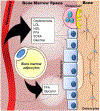Lipids in the Bone Marrow: An Evolving Perspective
- PMID: 31668874
- PMCID: PMC7004849
- DOI: 10.1016/j.cmet.2019.09.015
Lipids in the Bone Marrow: An Evolving Perspective
Abstract
Because of heavy energy demands to maintain bone homeostasis, the skeletal system is closely tied to whole-body metabolism via neuronal and hormonal mediators. Glucose, amino acids, and fatty acids are the chief fuel sources for bone resident cells during its remodeling. Lipids, which can be mobilized from intracellular depots in the bone marrow, can be a potent source of fatty acids. Thus, while it has been suggested that adipocytes in the bone marrow act as "filler" and are detrimental to skeletal homeostasis, we propose that marrow lipids are, in fact, essential for proper bone functioning. As such, we examine the prevailing evidence regarding the storage, use, and export of lipids within the skeletal niche, including from both in vitro and in vivo model systems. We also highlight the numerous challenges that remain to fully appreciate the relationship of lipid turnover to skeletal homeostasis.
Keywords: adipocytes; bone; cholesterol; diet; energy; fat; osteoblasts.
Copyright © 2019 Elsevier Inc. All rights reserved.
Conflict of interest statement
Declaration of Interests
The authors declare no competing interests.
Figures



References
-
- de Araújo IM, Salmon CE, Nahas AK, Nogueira-Barbosa MH, Elias J Jr, de Paula FJ (2017) Marrow adipose tissue spectrum in obesity and type 2 diabetes mellitus. Eur J Endocrinol. 176(1):21–30. - PubMed
-
- Bartelt A, Beil FT, Müller B, Koehne T, Yorgan TA, Heine M, Yilmaz T, Rüther W, Heeren J, Schinke T, et al. (2014). Hepatic lipase is expressed by osteoblasts and modulates bone remodeling in obesity. Bone 62, 90–98. - PubMed
-
- van Beek E, Pieterman E, Cohen L, Löwik C, and Papapoulos S (1999). Farnesyl Pyrophosphate Synthase Is the Molecular Target of Nitrogen-Containing Bisphosphonates. Biochem. Biophys. Res. Commun 264, 108–111. - PubMed
Publication types
MeSH terms
Substances
Grants and funding
LinkOut - more resources
Full Text Sources
Medical
Research Materials

